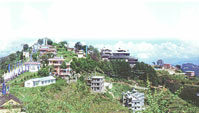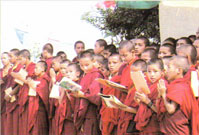
Namo Buddha, Thrangu Tashi Choling
 Located in the mountains about two and a half hours from Kathmandu, Namo Buddha is one of the most important Buddhist pilgrimage sites in Nepal and one of the holiest in the world. In one of his previous lives as a prince, it was here that the Buddha gave up his body out of compassion for a starving tigress and her cubs. Hence Namo Buddha is known by Tibetans and people of the Himalayan regions as ‘Takmo Lu Jin’, literally ‘Tigress Body Generosity’. Thrangu Rinpoche owns some land in this area, having already established several buildings and centres there, including the Namo Buddha retreat centre.
Located in the mountains about two and a half hours from Kathmandu, Namo Buddha is one of the most important Buddhist pilgrimage sites in Nepal and one of the holiest in the world. In one of his previous lives as a prince, it was here that the Buddha gave up his body out of compassion for a starving tigress and her cubs. Hence Namo Buddha is known by Tibetans and people of the Himalayan regions as ‘Takmo Lu Jin’, literally ‘Tigress Body Generosity’. Thrangu Rinpoche owns some land in this area, having already established several buildings and centres there, including the Namo Buddha retreat centre.
In the year 2000, Rinpoche opened the Namo Buddha branch school for young monks at Namo Buddha. This school was opened with the specific purpose of giving a secular education to young monks.
 Many of the young monks at the Namo Buddha school are children who come from poor villages in remote regions in the Himalayas. Their families often cannot support them or they may be orphans. All these children will be illiterate and mostly malnourished. They have no access to education, no opportunities to improve their situation, and have
barely adequate clothing, wearing hand-me-down rags. Rinpoche offers these children a way out of poverty, a quality education, and a bright future. He gives them a chance
of joining his school system with or without ordination (see Shree Mangal Dvip project page) as a monk.
Many of the young monks at the Namo Buddha school are children who come from poor villages in remote regions in the Himalayas. Their families often cannot support them or they may be orphans. All these children will be illiterate and mostly malnourished. They have no access to education, no opportunities to improve their situation, and have
barely adequate clothing, wearing hand-me-down rags. Rinpoche offers these children a way out of poverty, a quality education, and a bright future. He gives them a chance
of joining his school system with or without ordination (see Shree Mangal Dvip project page) as a monk.
Based on his vision of the neccessity of unity of religion with contemporary secular culture, Thrangu Rinpoche strongly requests support for his school- going monks, in particular for the monks at Namo Buddha. He points out that the more monks get a secular as well as the traditional monastic education, the more they will be able to understand all sentient beings, and help others develop an understanding of Dharma, which will benefit the wider community.
The monks at the Namo Buddha branch school follow the same curriculum as the children in the SMD school. This is an enriched version of the Nepali government curriculum: Instruction is given in all core subjects including maths, PE, arts, social studies science and three languages; Nepali, Tibetan and English, each of which has its own script and grammar. There is also a computer skills class, and elective classes—senior students must choose two from: 1) Health, environment and population, 2) Accounting (life skills), and 3) General knowledge (world/Nepali history and the history of humanity).
The monks sit the national board exams for classes 8 and 10. On top of their secular education, the monks study in the mornings before classes start and study Dharma texts in the late afternoons. They do a cycle of pujas—one a day (Chenrezig, Green Tara, Mahakala, Guru Rinpoche, Medicine Buddha and White Tara). They dedicate the merit to all sentient beings, especially their sponsors! The young monks also learn debate, and practice the Four Preliminaries. As the young monks receive both a secular and traditional education, their days are a little more rigorous than those of the SMD main school students—they have classes 6 days a week, from 9am to 3pm.
One of Lama Wangyal’s duties here in the UK is to raise funds on behalf of the young monks, and in order to achieve this aim, he has appointed the secretary as the Namo Buddha Fund manager in Oxford, and arranged for a new bank account, the Namo Buddha Fund, to be opened by the treasurer. Lama can say that from his own experience, it is extremely difficult to look after all the 200 plus young monks at the school; there are no families around to help, and there is often not adequate food or money for medicines, clothes and other basic necessities. Lama also says that they have a big problem getting enough safe drinking water, as the supply is very bad; the location of Namo Buddha in the countryside makes it a difficult place without good services.
There are not many donations coming in and the recent political strife in Nepal has discouraged tourism, all of which makes the situation more desperate. Lama is keen that people make the effort to help in any way they can, and says that the help of people in such a prosperous country as England can really go a long way towards improving the quality of life for those in such poor societies.
It costs £390 to sponsor a young monk, for one year. This money covers all costs of education. If you cannot afford £390 a year, then you may set up a regular standing order for a lesser amount, or simply give a smaller one-off amount.
Project website:/www.namo-buddha.org
All donations are very welcome, and there are several ways you can donate.
Our Projects
Thrangu House in Oxford
-
42 Magdalen Road
Oxford
OX4 1RB
Tel : 01865 241555
Email : secretary@thranguhouse.org.uk
Donate to Thrangu House
Please help our projects today.